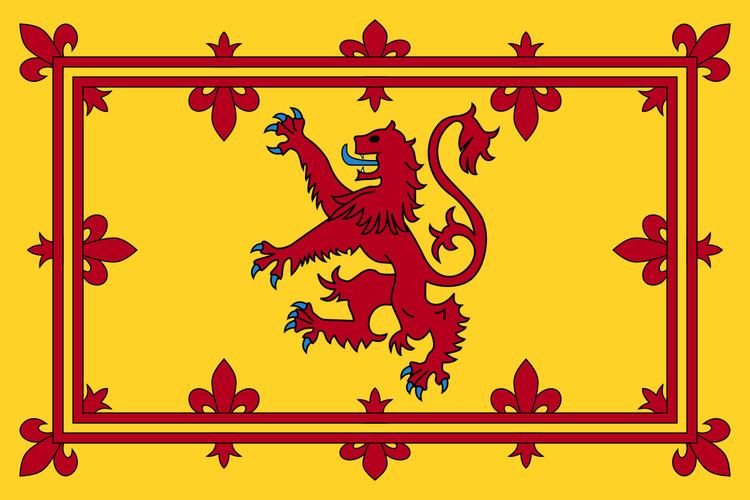 | ||
The Lord High Commissioner to the General Assembly of the Church of Scotland is the British Sovereign's personal representative to the General Assembly of the Church of Scotland (the Kirk), reflecting the Church's role as the national church of Scotland, and the Sovereign's role as protector and member of that Church.
Contents
History
Lord High Commissioners were appointed to the Parliament of the Kingdom of Scotland between 1603 and 1707 as the Sovereign's personal representative. The Act of Union 1707 made this function redundant, but a Lord High Commissioner to the General Assembly of the Church of Scotland has been appointed each year, as the Sovereign's personal representative, since 1690.
Prior to 1929 the General Assembly was held in the former Tolbooth Highland St John's Church on Edinburgh's Royal Mile (this building is no longer used as a church, instead being converted into "The Hub" for the Edinburgh International Festival society). A Throne was provided for the use of the Lord High Commissioner. The union of the Church of Scotland and the (non-established) United Free Church of Scotland took place in 1929. Since 1930 the General Assembly has always met in the former United Free Church Assembly hall on The Mound, Edinburgh. The Lord High Commissioner sits on the Throne in the Royal Gallery, which is technically "outside" the Assembly Hall - symbolising the independence of the Church in matters spiritual from state interference. The very first Assembly of the newly united church in 1929 was held in halls in Annandale Street, Edinburgh (now a bus garage), the only building large enough. Difficulty in accessing the Royal Gallery in this temporary location led to a seemingly trivial but nevertheless embarrassing dispute over protocol, whereby the Lord High Commissioner (the Duke of York, later King George VI) would have had to enter through the Assembly Hall itself - an act of symbolic state interference in the hard-won spiritual independence of the church. The Moderator, Dr John White, was adamant that this would be unacceptable, even suggesting that the post of Lord High Commissioner could be dispensed with. Eventually a suitable arrangement was agreed upon and the office of Lord High Commissioner has survived.
Functions
The office has always been largely ceremonial. The person appointed invariably has a distinguished record of public service in Scotland as well as having close connections with the church, often being an Elder of the Church of Scotland.
On behalf of the Sovereign, the Lord High Commissioner attends the General Assembly, makes opening and closing addresses to the Assembly, and carries out a number of official visits and ceremonial functions, not all related to the Church of Scotland. At the formal opening of the General Assembly, the Principal Clerk reads out the Royal Warrant appointing the Lord High Commissioner. The Lord High Commissioner is then invited to address the Assembly. All ministers, elders and deacons appointed by Presbyteries to attend the General Assembly are known as "Commissioners" and have voting powers; the Lord High Commissioner has no vote, nor may he/she intervene in debates.
Apart from his/her opening and closing addresses the Lord High Commissioner makes no further intervention in Assembly debates, but will be in daily attendance for at least part of each day's business. Following the Assembly the Lord High Commissioner personally informs The Queen about the business of the week.
Form of address
While the General Assembly is meeting, the Lord High Commissioner is treated as if a Regent. By custom, he or she is addressed as "Your Grace", and is greeted with a bow or curtsey. When The Princess Royal was appointed in 1996, she was styled as "Her Grace" for the duration rather than her normal dynastic style "Her Royal Highness" because the Lord High Commissioner is ranked higher in the order of Precedence.
If a woman is appointed to the office, the alternative title "Her Majesty's High Commissioner" may, if requested, be used. Margaret Herbison was the first woman to hold the post (1970 & 1971).
Residence
Since 1834 the Lord High Commissioner has resided at the Palace of Holyroodhouse and gave a garden party for Commissioners to the General Assembly on the Saturday afternoon of Assembly week and other hospitality. He or she is entitled to use the Scottish Royal Banner flag, and has precedence immediately after the Sovereign and the Duke of Edinburgh and before the rest of the Royal Family. Even his or her official car receives special treatment and, except for The Queen's, is the only vehicle in the country not to have number plates. However, the plates are re-attached during the closing speech of the Assembly, and the Lord High Commissioner returns to his royal but temporary residence as an ordinary citizen. In recent years, the garden party has been replaced by the "Heart and Soul" event, held in Princes Street Gardens and attended by the Lord High Commissioner.
Household
There is a Household of His Grace the Lord High Commissioner. This includes the Purse Bearer (who is the head of the Household), Chaplain, Aides-de-Camp (three in 1949), a Lady-in-Waiting, Extra Lady-in-Waiting, and Maids of Honour (three in 1949). The Macebearer bears the Lord President's Mace or the Old Exchequer Mace. The Master of the Horse is no longer appointed. The subordinate staff further includes the Assistant to the Purse Bearer, and a Lady's Maid. The Household make no financial demands on the funds of the Church of Scotland which are devoted exclusively to the Parish and Mission work of the Kirk
